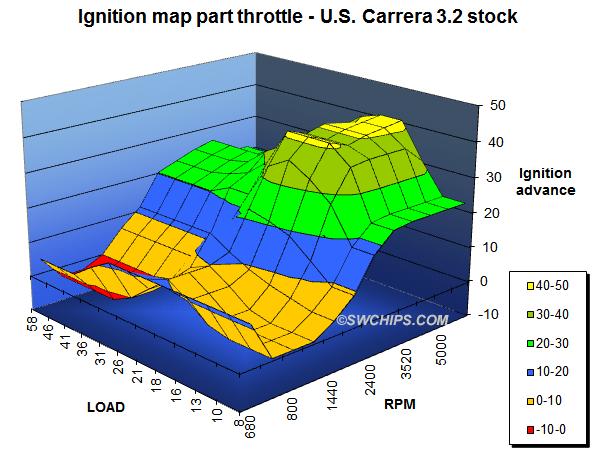gridwalker wrote:Ok, seeing as throttle maps are the topic du jour (so to speak) I have a question that dates back to before I joined the forum : many years ago, I remember the FIA moving to abolish "3D engine maps" but I am not certain what the 3D part of that means. I know that policing advanced mapping systems like this was part of the argument behind moving to the standard ECU, but I never found out what a 3D engine map does ... can anyone shed some light?
no expert in this matter, so allways open to be corrected by someone more knowledgeable.
But, for what it is worth, I think we should differentiate between a throttle map and a engine map.
I think the term "engine map" is perhaps a bit of a missnormer.
Within the "mapping of the engine" you will find many different maps, like ignition map, injection map etc. etc.
I would say, that today allmost any single map is at least a 3D map.
as an example here a ignition map

A 3D map, is nothing more then a 3 dimensional table to look up values.
The output variable (ignition timing in this case) will be defined by two other variables, in this case rpm and load (manifold pressue/vacuum for example).
In a 2D map, the output variable would only be defined by one input variable.
Ignition timing vs. rpm for example. It´s a simple look up table.

the output variable can now be used in other calculations or in another table.
in engine maps, this is sometimes refered to as corrections. Which means that the output variable get´s "corrected" by other variables, like water temperature, exhaust temp, knock sensor signals etc.
With modern simulation tools and more powerful computers (ECU calculation speed and memory size) it would be possible to anticipate/calculate in "real time" the power/torque output of the engine, based on injection/ignition timing.
Sure that´s very simplified, as things like inertia and other factors play into this as well.
But what the ECU could do, providing it is powerful enough (speed/memory), and the models accurate enough, is to calculate how much torque my rear wheels can handle under the current conditions.
For this the ECU would need to run a vehicle model, accounting for things like tire slip curves, lat/long acceleration/ yaw rate/ velocity / aeroforces/downforce etc.) then it could adjust the power/torque output of the engine to not exceeding the grip available. If you like traction control before the fact.
A old style traction control would sense that the tires have exceeded their grip limit, and that you have now wheelspin, trying to cut back on the input to come back into the area where the tire grips again.
The "new" controllers try to anticipate this limit, and trying to operate as close as possible to the limit line.
10 years ago, the controllers where probably not powerful engough to perform all this calculations in real time, but with ever increasing hardware performance it becomes more and more possible.
I can´t remember exactly what the FIA has banned back in the days, possible it was a 3D throttle map, as this would be on of the core parameters of a torque controller.
In an engine with a direct mechanical link between the throttle pedal and the throttle body at the engine, the opening of the engine throttle is a direct function (not neccessary linear) of the pedal position.
Early/simple drive by wire systems would just "mimic" such a mechanical link, newer torque controller layouts as used in F1 now and in most modern road cars with drive by wire, will use the throttle pedal imput only as a "torque request/ go-pedal if you like" and adjust the throttle at the engine, the ingnition and injection accordingly to ensure the best possible engine response to the request of the driver.
With this there is better control over the A/F ratio, as you can adjust the air (throttle at the engine) and the Fuel (injector opening/fuel pressure) seperate.
With an "old style" throttle, the driver would define the air component directly with the pedal position, even if it is not ideal, the ECU then could only suppply fuel and ignition timing.
I think (put I could be wrong) that Ferrari and some others had early versions of torque controllers back in the days after T/C was banned, making it for the driver more easy to get the power down, using something like an open loop/forward looking controll.
Back in the days, this would requiere some powerful ECU´s and advanced programming, which perhaps was not widely availible at the time.
Today a torque controller is a pretty standard layout, even in road cars and all F1 engine using it.
Sure some are better then others, but this is with allmost anything the case.
If F1 goes to Direct Injection, "perfect(er)" control will be much easier to achieve, as the fuel rate can be much better controlled.
With port injection, you need to account for things like wall wetting and port dryout etc, meaning you need more "fudge factors" in your calculations.




